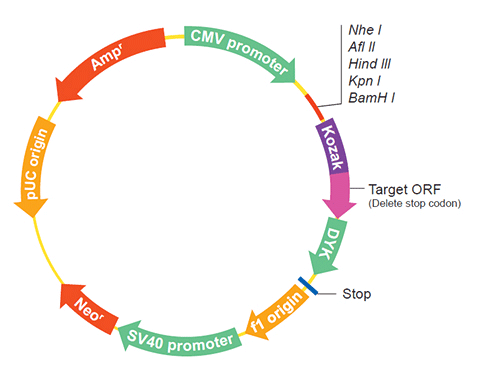| Gene Symbol | AgaP_AGAP002164 |
| Entrez Gene ID | 1269393 |
| Full Name | AGAP002164-PA |
| Synonyms | AgaP_ENSANGG00000021021,ENSANGG00000021021 |
| Gene Type | protein-coding |
| Organism | Anopheles gambiae str. PEST |
HOME
ORF » Species Summary » Anopheles gambiae str. PEST » AgaP_AGAP002164 cDNA ORF clone
| Gene Symbol | AgaP_AGAP002164 |
| Entrez Gene ID | 1269393 |
| Full Name | AGAP002164-PA |
| Synonyms | AgaP_ENSANGG00000021021,ENSANGG00000021021 |
| Gene Type | protein-coding |
| Organism | Anopheles gambiae str. PEST |
| mRNA | Protein | Name |
|---|---|---|
| XM_308027.2 | XP_308027.2 | AGAP002164-PA |


The Anopheles gambiae genome: an update.
Mongin E, Louis C, Holt RA, Birney E, Collins FH
Trends in parasitology20(2)49-52(2004 Feb)
The genome sequence of the malaria mosquito Anopheles gambiae.
Holt RA, Subramanian GM, Halpern A, Sutton GG, Charlab R, Nusskern DR, Wincker P, Clark AG, Ribeiro JM, Wides R, Salzberg SL, Loftus B, Yandell M, Majoros WH, Rusch DB, Lai Z, Kraft CL, Abril JF, Anthouard V, Arensburger P, Atkinson PW, Baden H, de Berardinis V, Baldwin D, Benes V, Biedler J, Blass C, Bolanos R, Boscus D, Barnstead M, Cai S, Center A, Chaturverdi K, Christophides GK, Chrystal MA, Clamp M, Cravchik A, Curwen V, Dana A, Delcher A, Dew I, Evans CA, Flanigan M, Grundschober-Freimoser A, Friedli L, Gu Z, Guan P, Guigo R, Hillenmeyer ME, Hladun SL, Hogan JR, Hong YS, Hoover J, Jaillon O, Ke Z, Kodira C, Kokoza E, Koutsos A, Letunic I, Levitsky A, Liang Y, Lin JJ, Lobo NF, Lopez JR, Malek JA, McIntosh TC, Meister S, Miller J, Mobarry C, Mongin E, Murphy SD, O'Brochta DA, Pfannkoch C, Qi R, Regier MA, Remington K, Shao H, Sharakhova MV, Sitter CD, Shetty J, Smith TJ, Strong R, Sun J, Thomasova D, Ton LQ, Topalis P, Tu Z, Unger MF, Walenz B, Wang A, Wang J, Wang M, Wang X, Woodford KJ, Wortman JR, Wu M, Yao A, Zdobnov EM, Zhang H, Zhao Q, Zhao S, Zhu SC, Zhimulev I, Coluzzi M, della Torre A, Roth CW, Louis C, Kalush F, Mural RJ, Myers EW, Adams MD, Smith HO, Broder S, Gardner MJ, Fraser CM, Birney E, Bork P, Brey PT, Venter JC, Weissenbach J, Kafatos FC, Collins FH, Hoffman SL
Science (New York, N.Y.)298(5591)129-49(2002 Oct)
GeneRIFs: Gene References Into Functions What's a GeneRIF?
The following AgaP_AGAP002164 gene cDNA ORF clone sequences were retrieved from the NCBI Reference Sequence Database (RefSeq). These sequences represent the protein coding region of the AgaP_AGAP002164 cDNA ORF which is encoded by the open reading frame (ORF) sequence. ORF sequences can be delivered in our standard vector, pcDNA3.1+/C-(K)DYK or the vector of your choice as an expression/transfection-ready ORF clone. Not the clone you want? Click here to find your clone.
| CloneID | OAh00480 | |
| Clone ID Related Accession (Same CDS sequence) | XM_308027.2 | |
| Accession Version | XM_308027.2 Latest version! | Documents for ORF clone product in default vector |
| Sequence Information | ORF Nucleotide Sequence (Length: 261bp) Protein sequence SNP |
|
| Vector | pcDNA3.1-C-(k)DYK or customized vector |  User Manual User Manual |
| Clone information | Clone Map |  MSDS MSDS |
| Tag on pcDNA3.1+/C-(K)DYK | C terminal DYKDDDDK tags | |
| ORF Insert Method | CloneEZ™ Seamless cloning technology | |
| Insert Structure | linear | |
| Update Date | 2018-04-25 | |
| Organism | Anopheles gambiae str. PEST | |
| Product | AGAP002164-PA | |
| Comment | Comment: PROVISIONAL REFSEQ: This record has not yet been subject to final NCBI review. This record is derived from an annotated genomic sequence (NT_078266). On Dec 7, 2006 this sequence version replaced XM_308027.1. COMPLETENESS: incomplete on both ends. | |
1 | ATGAGCCTAA GCTATCTGTC GCTCATACGT GGCTGCTCTC CTAAGAAACT GTTTTCATGC |
The stop codons will be deleted if pcDNA3.1+/C-(K)DYK vector is selected.
| RefSeq | XP_308027.2 |
| CDS | 1..261 |
| Translation |

Target ORF information:
Target ORF information:
|
 XM_308027.2 XM_308027.2 |

1 | ATGAGCCTAA GCTATCTGTC GCTCATACGT GGCTGCTCTC CTAAGAAACT GTTTTCATGC |
The stop codons will be deleted if pcDNA3.1+/C-(K)DYK vector is selected.
The Anopheles gambiae genome: an update. |
The genome sequence of the malaria mosquito Anopheles gambiae. |